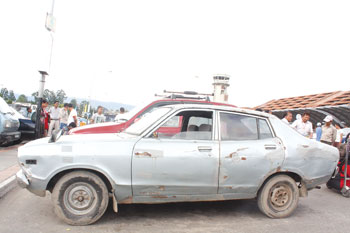Kathmandu’s airport taxis look like museum pieces ... finally they are going to be replaced by newer cars
You have just landed in Kathmandu and the last thing you need after a long flight and a long line at immigration is to be hassled by taxi touts who want you to pay through your nose for a ride into town in a 40-year-old Datsun.
After decades of wrangling and rumours of kickbacks in high places, Kathmandu airport taxis are finally going to be replaced by the latest model sedans, hatchbacks, and vans.
“Every time I come to Kathmandu, I avoid the airport taxi and head over to the departure area and hail a cab that has just dropped a passenger,” says David Dubois, a French photographer, “that way I never get fleeced by the airport taxi service.”
Now, arriving passengers like Dubois won’t feel so bad about paying exorbitant rates for an airport cab because the museum pieces are being replaced by newer cars. Tribhuvan International Airport (TIA) management has struck a deal with airport taxi owners to add new cars to its service and retire some of the antique models. Forty green-plated white Ford Classics, Ford Figos, and Maruti Eecos will be lined up at the arrival area from August. Another 160 will follow by the start of the tourist peak season in October.

DEVYANI SHIWAKOTI
BEFORE AND AFTER: A vintage 1976 model Toyota still takes passengers from the airport to the city, but brand new green-plate Ford Figos like this one will start replacing them next month.
“We had been planning this for many years and we’re glad to have finally found a balance that satisfied all parties,” says Shyam Sundar Shrestha, deputy manager at TIA. “Now our new taxis will have uniformed and name-tagged drivers who can speak English with visitors.”
The current charge-as-you-like practice will also be upgraded to a standard prepaid service. Passengers will make a payment at a counter in the arrival lounge and then hand the receipt to the driver at the end of their ride.
All these years, taxi owners, under powerful unions with political protection, were cheating passengers and refusing to pay any fee for their lucrative business. Not only were the cars old, but passengers were overcharged, service was terrible, and the cars usually broke down on the way into the city. The new taxi service will also provide the airport with an additional Rs 3,200,000 in revenue each year.
As early as 2003, some taxi owners had tried to get their old cars replaced, however, negotiations stalled with the government on taxes and on what should happen to the old cars. Fights broke out between owners. Now, the Airport Hawai Yatru Sewa Byawasthapan Limited (AHYSBL) has won the taxi-replacement bid and will be handling airport transport.
Purushottam Simkhada of AHYSBL says they convinced everyone from owner to driver to agree to this change. “The deal we made with the ministry allows us to keep some of the relatively newer vehicles,” he says. “For taxi drivers, we have arranged for soft loans so that they may become taxi-owners. The really old vehicles may be sold off to scrap yards or whoever finds them useful.” Transportation rules in Nepal forbid the re-registration of vehicles of more than 20 years old.
The airport is busiest between 11am to 3pm and sees around 1,500 passengers arriving every day. Together with the Sajha public bus service, passengers will have a range of options of going into town.
Says Shrestha: “The airport had a bad reputation because of the old taxis, hopefully that will not be the case anymore as we phase out the old vehicles.”